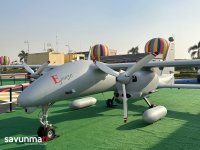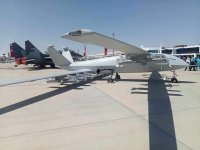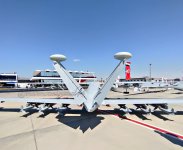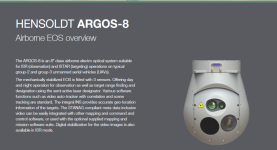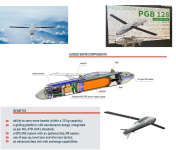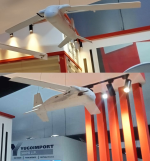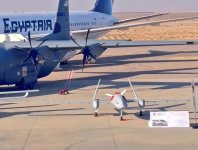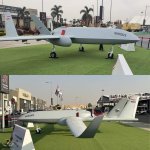We start the topic with an explanatory article, then we discuss the current situation.
Savvas Vlassis26/12/2021
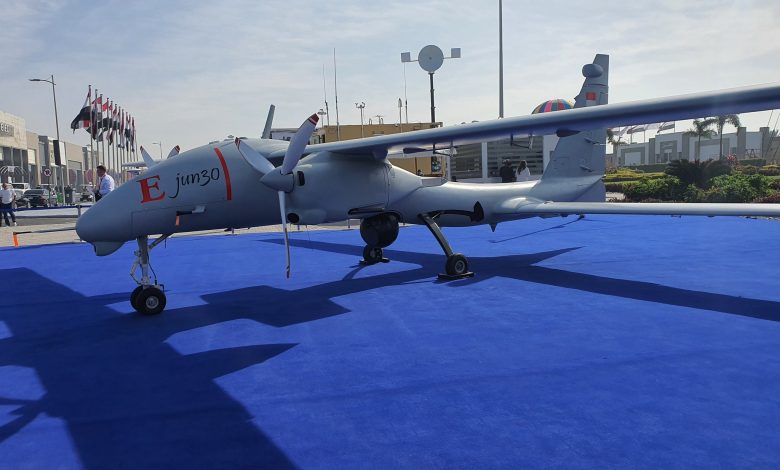
From Savvas D. Vlassis
During the EDEX 2021 exhibition in Cairo between November 29 – December 2, the Egyptian Armed Forces unveiled the EJun 30 SW, a UAV built by Industrial Complex Engineering Robots in collaboration with the Egyptian Ministry of Military Production. The EJun 30 SW bears a striking resemblance to the Yabhon Flash-20 (and not the Yabhon United 40 that most foreign sources reported) a UAV developed by Adcom Systems, a United Arab Emirates company, primarily for the UAE Air Force. Therefore, the EJun 30 SW was considered the Egyptian version of the Yabhon Flash-20.
The Yabhon Flash-20 has appeared in versions A and B, with a length of 8.9 meters and wingspan of 12 and 18 meters respectively. Maximum take-off weight is respectively 1,450 and 1,650 kg, maximum payload 300 and 460 kg, fuel weight in wing tanks is 650 and 800 kg. In terms of performance of the A and B versions, the maximum speed is 130 and 125 knots respectively, the autonomy with maximum load is 22 and 24 hours while the operational ceiling is 26,000 feet for both versions.
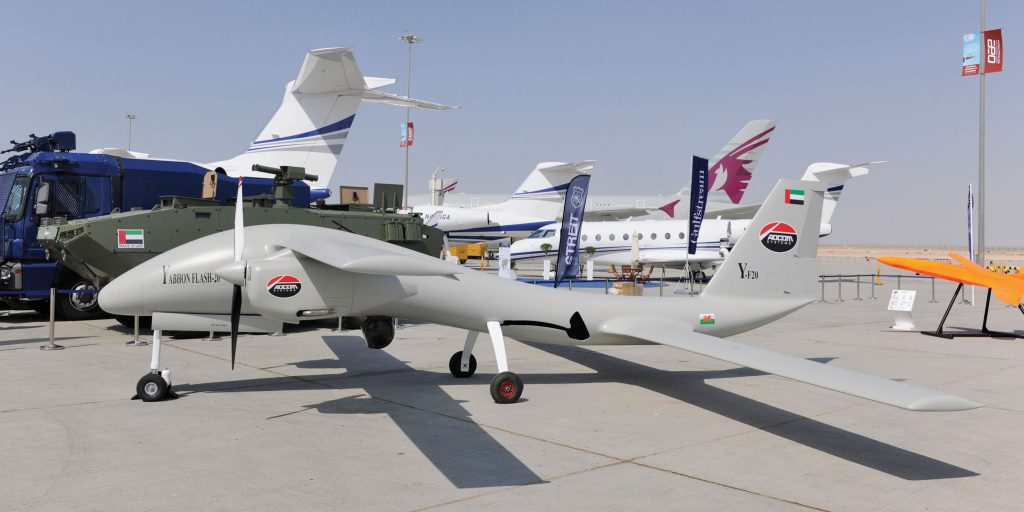
The larger Yabhon United 40 appeared as a scale model in 2007 and was presented in prototype form at the 2013 Dubai Air Show. It belongs to the Medium Altitude Long Range (MALE) category with a maximum flight altitude of 7,010 meters, speed between 75-220 kph. and flight range of 120 hours (5 days). The aircraft carries 4 underwing cargo carriers, with a payload of 1,050 kg. In open sources, the UAV is reported to carry two Rotax 914UL four-cylinder turbocharged engines of 114 hp each, but the chief designer of Adcom Systems had mentioned during the initial appearance of the Yabhon United 40 that there is a 115 hp main engine and an 80 hp electric motor. Open sources say the aircraft has synthetic imaging radar (SAR) and terrain avoidance systems in addition to the electro-optical sensor, but the configuration in Egyptian service is unknown.
The general design line of the Yabhon family, mainly in the fuselage of the so-called “S” configuration, is very reminiscent of the heavy armed Akinci-type UAV developed by the Turkish Baykar. There are of course differences, such as the lack of tail main wings, the "split" main wing and the two 450 hp AI-450C turboprop engines. With a length of 12.3 meters, a wingspan of 20 meters, a maximum take-off weight of 5,500 kg and a payload of 1,350 kg (450+ internal, 900 kg external) it is clear that the Akinci is a larger design.

As the resemblance is no coincidence, it can be safely assumed that Akinci is a co-development between Adcom Systems and Baykar, the latter having acquired an exclusive partnership design to adapt it to domestic needs and to NATO standards. This is common practice internationally, after the collapse of the Warsaw Pact and the evolution of globalization that favors the movement of people. As product designs from companies or design offices cannot always be absorbed by the domestic market of their country, it is common practice for commercial cooperation agreements to sell designs to foreign companies that do not want to enter into a process of "reinventing the wheel" but to add a new product to their wallet within a reasonable period of time.
Turkey's Baykar, founded in 1984, was an engineering company producing engines, pumps and spare parts for vehicles, which only made an opening in the UAV sector in the 2000s. Ozdemir Bayraktar, the owner of the company, with previous involvement in weapons programs and close relations with the Turkish armed forces, turned his interest in the field of UAVs in 2004. Seljuk's son, in 2005, publicly called on government officials to invest in UAV technologies, stating that within five years the country could be a world leader in the field. The call was "embraced", because in Turkey there is a specific central policy for the development of the domestic defense industry and certainly state funding was allocated to support the relevant development programs.
With the financial issue resolved, such an opening and the appearance of products in a reasonable period of time by a company unrelated to the space, can only face the technological challenge through cooperation. Collaborating with a foreign house, or at least hiring a group of foreign engineers who could offer some UAV design, was a natural solution.
Adcom Systems is a group of more than 20 private companies, based in the UAE, that started producing the first UAVs in 2002. The company had started its activity with the development of missiles and then radar systems. Today it has introduced the Yabhon series, including HALE and MALE class versions while the Yabhon NSR is said to be the world's first UAV capable of shooting down other UAVs. As the company also produces air weapons, it can offer a complete armed UAV.
Adcom Systems' entry into the field of heavily armed UAVs began with a political decision, after the US refused to sell the MQ-9 Reaper to the UAE. Turkey had the same motivation, which literally "out of nowhere", Baykar displayed the successful Bayraktar TB2, which was subsequently developed into the armed version TB2S and today has presented the Akinci.
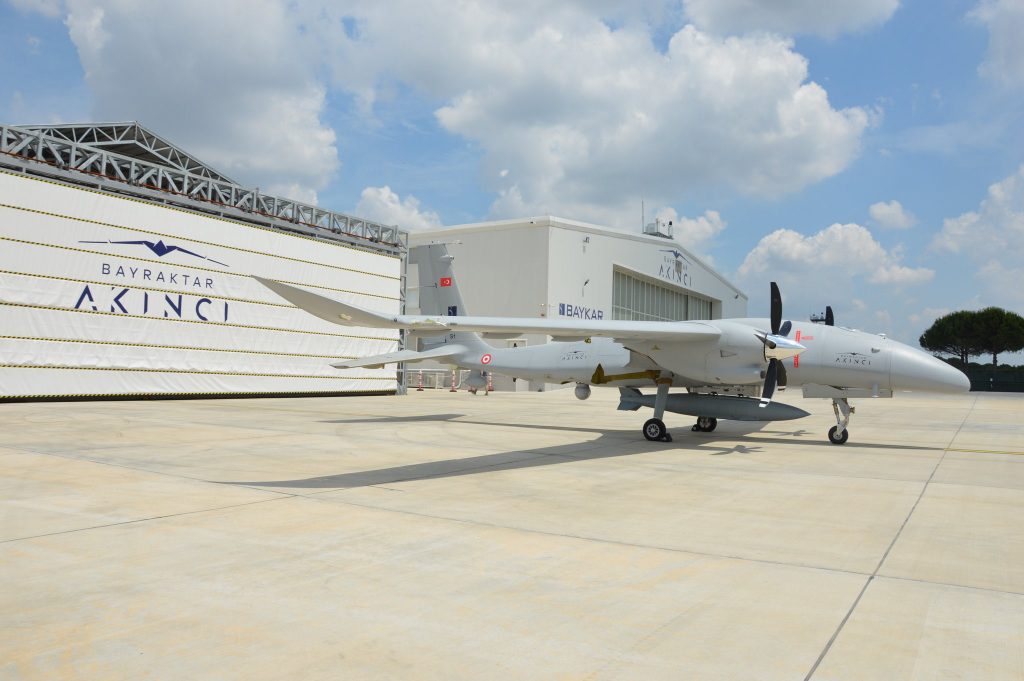
As reported by Adcom Systems, the management is carried out by a multinational group while more than 600 employees are employed. This is a typical case of attracting foreign scientific personnel who responded to the official "call" of the UAE government, when years ago it decided to develop a domestic defense industry. Quite simply, to compensate for the problem of the lack of experienced personnel in the field, the UAE hired experienced mechanical engineers and scientific personnel of all specialties at very attractive salaries. In this way, notable companies were developed in various sectors in the UAE, which were able to develop products of all kinds (portable weapons, vehicles, missiles, UAVs) in a very short time.
Since 2013, Adcom Systems has already been advertising the international interest in its UAVs. Its head had reported at the time that even Russia had expressed interest, as more than 10 countries had expressed interest and the company had made several demonstrations. Very likely Turkey and Baykar was one of them. The "internationalization" of its products began with the Belar YS-EX, a version of the Yabhon Flash-20, presented in 2017 by KB Indela from Belarus. Founded in 1996 in Minsk and active in the field of UAVs, the company was acquired in 2013 by Adcom Systems and sought to penetrate the Russian market. The interest shown by Russia in the Yabhon United 40 does not seem to have been a coincidence, as was the offer of various designs in the following years by KB Indela.
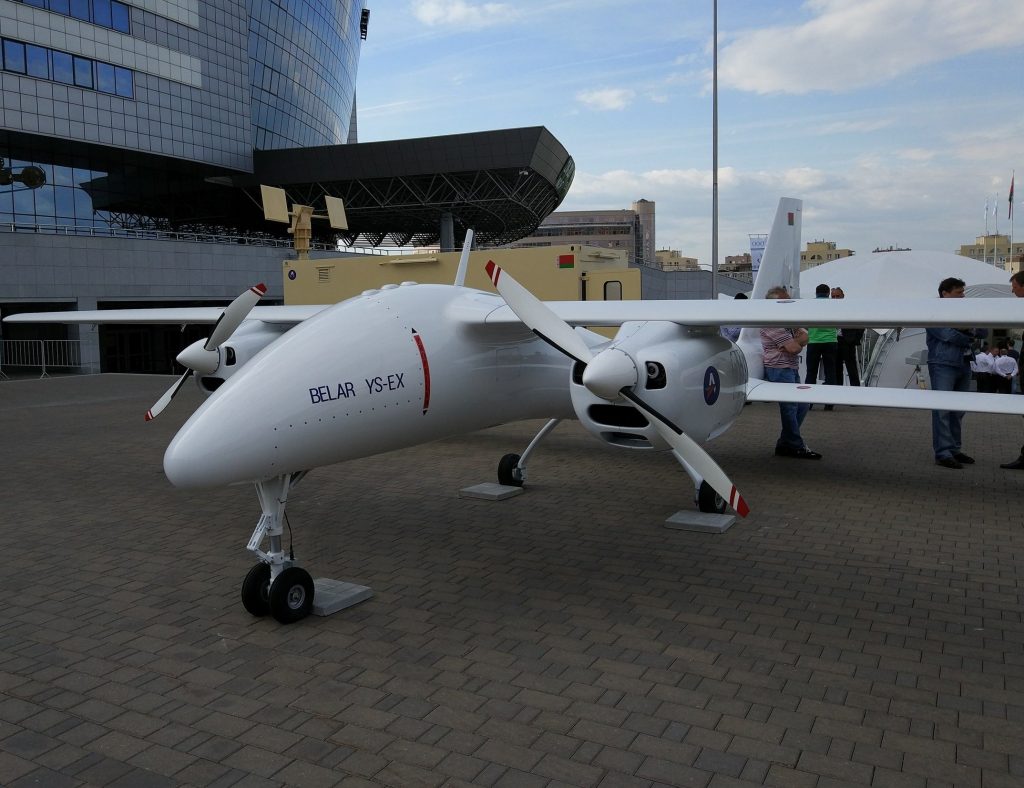
Egypt, presenting the EJun 30 SW, has probably chosen to work with Adcom Systems to make its own forays into the field. Turkey, it seems, took the lead and thanks to earlier cooperation, chose a more sophisticated and higher performance design.
The UAE maintained good relations with Turkey but after the failed coup in July 2016, Erdogan directly accused the UAE crown prince as one of the instigators, calling him " Turkey's worst enemy ". Since then, bilateral relations have further deteriorated in 2017, when the UAE and Saudi Arabia boycotted Qatar, a close ally of Ankara. However, this does not necessarily mean that any cooperation on a business level, such as a possible cooperation between Adcom Systems and Baykar, is stopped.
Chronologically, from what is known from open sources, the development and manufacture of armed HALE-class UAVs was expressed in Turkey in early 2016. Baykar, is reported to have started work at Akinci in May 2017 and on January 31, 2018, its proposal was selected. in June 2018 a contract was awarded and a year later, in June 2019, the preliminary design phase was completed and on December 6, 2019 the first flight took place. On August 29, 2021, Akinci's handover ceremony to the Turkish armed forces took place.
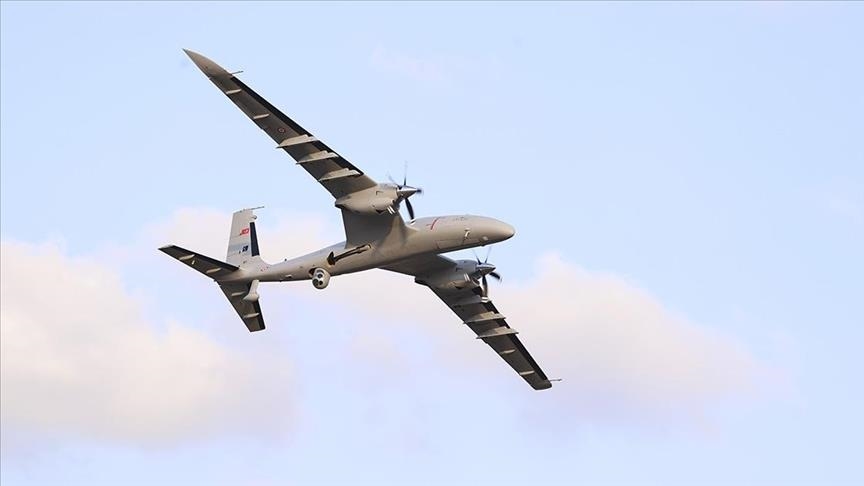
The emergence of Turkey as a world leading force in the field of UAVs resulted from the central government policy of developing domestic defense production, the financing of related development programs and, in the case of Baykar, the cooperation with an experienced foreign house that undertook the co-development based on an existing plan that modified according to Turkish needs.
In Greece, none of the above exists, which is why to date there is no final product of operational value in the field of UAVs.
Egyptian EJun 30 SW, Akinci and the relationship with the United Arab Emirates
Savvas Vlassis26/12/2021

From Savvas D. Vlassis
During the EDEX 2021 exhibition in Cairo between November 29 – December 2, the Egyptian Armed Forces unveiled the EJun 30 SW, a UAV built by Industrial Complex Engineering Robots in collaboration with the Egyptian Ministry of Military Production. The EJun 30 SW bears a striking resemblance to the Yabhon Flash-20 (and not the Yabhon United 40 that most foreign sources reported) a UAV developed by Adcom Systems, a United Arab Emirates company, primarily for the UAE Air Force. Therefore, the EJun 30 SW was considered the Egyptian version of the Yabhon Flash-20.
The Yabhon Flash-20 has appeared in versions A and B, with a length of 8.9 meters and wingspan of 12 and 18 meters respectively. Maximum take-off weight is respectively 1,450 and 1,650 kg, maximum payload 300 and 460 kg, fuel weight in wing tanks is 650 and 800 kg. In terms of performance of the A and B versions, the maximum speed is 130 and 125 knots respectively, the autonomy with maximum load is 22 and 24 hours while the operational ceiling is 26,000 feet for both versions.

The larger Yabhon United 40 appeared as a scale model in 2007 and was presented in prototype form at the 2013 Dubai Air Show. It belongs to the Medium Altitude Long Range (MALE) category with a maximum flight altitude of 7,010 meters, speed between 75-220 kph. and flight range of 120 hours (5 days). The aircraft carries 4 underwing cargo carriers, with a payload of 1,050 kg. In open sources, the UAV is reported to carry two Rotax 914UL four-cylinder turbocharged engines of 114 hp each, but the chief designer of Adcom Systems had mentioned during the initial appearance of the Yabhon United 40 that there is a 115 hp main engine and an 80 hp electric motor. Open sources say the aircraft has synthetic imaging radar (SAR) and terrain avoidance systems in addition to the electro-optical sensor, but the configuration in Egyptian service is unknown.
The general design line of the Yabhon family, mainly in the fuselage of the so-called “S” configuration, is very reminiscent of the heavy armed Akinci-type UAV developed by the Turkish Baykar. There are of course differences, such as the lack of tail main wings, the "split" main wing and the two 450 hp AI-450C turboprop engines. With a length of 12.3 meters, a wingspan of 20 meters, a maximum take-off weight of 5,500 kg and a payload of 1,350 kg (450+ internal, 900 kg external) it is clear that the Akinci is a larger design.

As the resemblance is no coincidence, it can be safely assumed that Akinci is a co-development between Adcom Systems and Baykar, the latter having acquired an exclusive partnership design to adapt it to domestic needs and to NATO standards. This is common practice internationally, after the collapse of the Warsaw Pact and the evolution of globalization that favors the movement of people. As product designs from companies or design offices cannot always be absorbed by the domestic market of their country, it is common practice for commercial cooperation agreements to sell designs to foreign companies that do not want to enter into a process of "reinventing the wheel" but to add a new product to their wallet within a reasonable period of time.
Turkey's Baykar, founded in 1984, was an engineering company producing engines, pumps and spare parts for vehicles, which only made an opening in the UAV sector in the 2000s. Ozdemir Bayraktar, the owner of the company, with previous involvement in weapons programs and close relations with the Turkish armed forces, turned his interest in the field of UAVs in 2004. Seljuk's son, in 2005, publicly called on government officials to invest in UAV technologies, stating that within five years the country could be a world leader in the field. The call was "embraced", because in Turkey there is a specific central policy for the development of the domestic defense industry and certainly state funding was allocated to support the relevant development programs.
With the financial issue resolved, such an opening and the appearance of products in a reasonable period of time by a company unrelated to the space, can only face the technological challenge through cooperation. Collaborating with a foreign house, or at least hiring a group of foreign engineers who could offer some UAV design, was a natural solution.
Adcom Systems is a group of more than 20 private companies, based in the UAE, that started producing the first UAVs in 2002. The company had started its activity with the development of missiles and then radar systems. Today it has introduced the Yabhon series, including HALE and MALE class versions while the Yabhon NSR is said to be the world's first UAV capable of shooting down other UAVs. As the company also produces air weapons, it can offer a complete armed UAV.
Adcom Systems' entry into the field of heavily armed UAVs began with a political decision, after the US refused to sell the MQ-9 Reaper to the UAE. Turkey had the same motivation, which literally "out of nowhere", Baykar displayed the successful Bayraktar TB2, which was subsequently developed into the armed version TB2S and today has presented the Akinci.

As reported by Adcom Systems, the management is carried out by a multinational group while more than 600 employees are employed. This is a typical case of attracting foreign scientific personnel who responded to the official "call" of the UAE government, when years ago it decided to develop a domestic defense industry. Quite simply, to compensate for the problem of the lack of experienced personnel in the field, the UAE hired experienced mechanical engineers and scientific personnel of all specialties at very attractive salaries. In this way, notable companies were developed in various sectors in the UAE, which were able to develop products of all kinds (portable weapons, vehicles, missiles, UAVs) in a very short time.
Since 2013, Adcom Systems has already been advertising the international interest in its UAVs. Its head had reported at the time that even Russia had expressed interest, as more than 10 countries had expressed interest and the company had made several demonstrations. Very likely Turkey and Baykar was one of them. The "internationalization" of its products began with the Belar YS-EX, a version of the Yabhon Flash-20, presented in 2017 by KB Indela from Belarus. Founded in 1996 in Minsk and active in the field of UAVs, the company was acquired in 2013 by Adcom Systems and sought to penetrate the Russian market. The interest shown by Russia in the Yabhon United 40 does not seem to have been a coincidence, as was the offer of various designs in the following years by KB Indela.

Egypt, presenting the EJun 30 SW, has probably chosen to work with Adcom Systems to make its own forays into the field. Turkey, it seems, took the lead and thanks to earlier cooperation, chose a more sophisticated and higher performance design.
The UAE maintained good relations with Turkey but after the failed coup in July 2016, Erdogan directly accused the UAE crown prince as one of the instigators, calling him " Turkey's worst enemy ". Since then, bilateral relations have further deteriorated in 2017, when the UAE and Saudi Arabia boycotted Qatar, a close ally of Ankara. However, this does not necessarily mean that any cooperation on a business level, such as a possible cooperation between Adcom Systems and Baykar, is stopped.
Chronologically, from what is known from open sources, the development and manufacture of armed HALE-class UAVs was expressed in Turkey in early 2016. Baykar, is reported to have started work at Akinci in May 2017 and on January 31, 2018, its proposal was selected. in June 2018 a contract was awarded and a year later, in June 2019, the preliminary design phase was completed and on December 6, 2019 the first flight took place. On August 29, 2021, Akinci's handover ceremony to the Turkish armed forces took place.

The emergence of Turkey as a world leading force in the field of UAVs resulted from the central government policy of developing domestic defense production, the financing of related development programs and, in the case of Baykar, the cooperation with an experienced foreign house that undertook the co-development based on an existing plan that modified according to Turkish needs.
In Greece, none of the above exists, which is why to date there is no final product of operational value in the field of UAVs.




